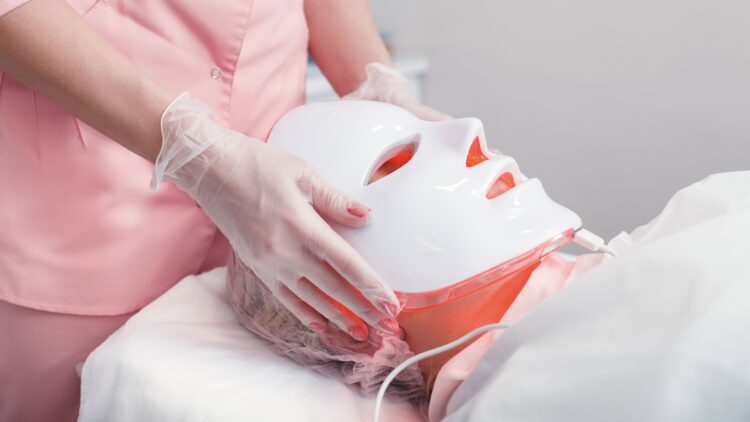Definition of Red Light Therapy
R
Red light therapy is a non-invasive and natural treatment that involves exposing the human skin to red and near-infrared light wavelengths. This type of skin care therapy is also known as low-level laser therapy (LLLT), low-power laser therapy (LPLT), photobiomodulation therapy (PBM), cold laser therapy and soft laser therapy.
The red light therapy devices emit light sources that penetrate deep into the skin cells to improve cellular function, increase blood flow, and reduce oxidative stress. Low-level laser light therapy is gaining popularity due to its numerous potential benefits, including improving the human skin health, promoting hair growth, reducing inflammation, increasing production in wound healing, and even potentially treating certain medical conditions.
Who invented Red Light Therapy?
Red light therapy, also known as low-level laser therapy or photobiomodulation therapy, has been gaining traction in recent years as a potential treatment for a wide range of health conditions. But where did this therapy originate, and who first discovered its benefits?

The origins of red light therapy can be traced back to the research of Hungarian scientist Endre Mester in the 1960s. Mester was studying the effects of low-level laser therapy on tumor cells in mice when he noticed something unexpected: the hair on the mice that had been treated with the laser started to grow back more quickly than on the untreated mice. Intrigued, Mester began to investigate further and found that in addition to stimulating hair growth, the laser therapy also had a surprisingly positive effect on production in wound healing.
Mester’s groundbreaking research laid the groundwork for the development of red light therapy as we know it today. However, it was largely ignored and considered bogus by the medical community for several decades.
It wasn’t until the 1980s that red light therapy began to gain some mainstream recognition. NASA became interested in the therapy as a potential treatment for wound care in astronauts, who were at risk of developing serious infections from even minor injuries in the low-gravity environment of space. NASA conducted numerous studies on the use of red light therapy to treat wounds, and found that it not only accelerated healing times but also showed promise as a treatment for a range of other conditions.
Despite the interest from NASA, red light therapy remained controversial and largely dismissed by many in the medical community. It was only in recent years, as more studies have been conducted and more people have experienced the benefits firsthand, that it has begun to gain wider acceptance.
Today, red light therapy is used for everything from improvements in skin complexion and reducing age spots to treating chronic pain and helping people with seasonal affective disorder (SAD). It is still a relatively new and evolving field, but one that holds a great deal of promise for the future.
About Red Light Therapy
Red Light Therapy is a non-invasive alternative therapy that uses specific wavelengths of light to stimulate cellular function and promote healing. There are two types of Red Light Therapy: Red-Light therapy Near-Infrared and Red-light therapy Mid-Infrared. Both types of therapy use specific wavelengths of light to penetrate deep into the human skin and promote healing.
Benefits of Near-Infrared (NIR) Red Light Therapy:
-Stimulates dermal collagen synthesis which leads to intradermal collagen density increase: Red light therapy leading to intradermal collagen density increase, which helps to reduce worsening of skin concerns such as skin roughness, wrinkles and fine lines, leading to improvements in skin complexion.
-Promotes wound care: Red light therapy has been shown to accelerate wound healing and reduce inflammation.
– Reduces the appearance of age spots: NIR red light therapy can reduce the appearance of age spots on the skin surface.
-Improves human skin tone: NIR red light therapy can help to improve worsening of skin roughness and skin tone, making skin appear smoother and more youthful.
-Aids in hair growth: Red light therapy can help stimulate hair growth in individuals who experience hair loss.
Benefits of Mid-Infrared (MIR) Red Light Therapy:
-Anti-inflammatory effects: MIR red light therapy can help to reduce inflammation in the body, which can help to alleviate pain and stiffness.
– Increases blood flow: MIR red light therapy can help to increase blood flow in the body, which can help to promote healing and reduce pain.
-Reduces healing time: MIR red light therapy has been shown to accelerate healing time in injuries and wounds.
– Improves human skin health: MIR red light therapy can help to improve skin health by reducing inflammation, improving worsening of skin roughness and skin tone, and reducing the appearance of age spots.
-Lowers oxidative stress: MIR red light therapy can help to decrease oxidative stress in the body, which can lead to reduced inflammation and improved cellular function.
Overall, Red Light Therapy is a safe and effective therapeutic tool that can be used to improve a wide range of health and cosmetic concerns. It is important to discuss the use of Red Light Therapy with a healthcare provider before beginning treatment to ensure that it is safe and appropriate for your individual needs.
Advantages of Red Light Therapy

Red light therapy has been gaining popularity among skincare enthusiasts and healthcare providers for its potential benefits. By using specific wavelengths of light, red light therapy can penetrate deep into the human skin and provide various therapeutic effects.
Although the research on the benefits of red light therapy is not consistent, experts agree that it could help reduce inflammation, promote the formation of new blood vessels, increase collagen production which leads to collagen density increase, boost antioxidants, and reduce cortisol production.
One of the most significant benefits of red light therapy is its ability to reduce inflammation in the body. Red light therapy may target the inflammation at the cellular level by triggering the production of cytokines. Cytokines are signaling proteins that control the immune response in the body, and by modulating their production, red light therapy can suppress inflammation.
Red light therapy can also promote blood vessel formation, which can help improve blood flow and circulation. Better circulation can lead to faster healing, better nutrient delivery, and more efficient waste removal from the cells. Additionally, red light therapy can stimulate collagen production which will lead to collagen increase, which can enhance skin elasticity and reduce the appearance of fine lines and wrinkles.
Moreover, red light therapy can boost antioxidant production, which can help fight oxidative stress in the body. Oxidative stress is a process that occurs when the body produces harmful reactive oxygen species (ROS) that can damage cells and tissues. By increasing antioxidant production, red light therapy can neutralize ROS and protect the cells from damage.
Finally, red light therapy may reduce cortisol production, which is the hormone responsible for the body’s stress response. High cortisol levels can lead to a range of adverse health effects, including weight gain, anxiety, and insomnia. By reducing cortisol production, red light therapy can contribute to stress reduction and better overall mental health.
In conclusion, while the research on red light therapy’s benefits is not definitive, experts agree that it could be an effective therapy to help reduce inflammation, promote blood vessel formation, increase intradermal collagen density which will boast collagen intensity score, increase antioxidants, and reduce cortisol production.
Disadvantages of Red Light Therapy
-May not be suitable for people with certain medical conditions such as epilepsy, lupus, and skin cancer.
-Red light therapy should not be used on open wounds or lesions as it can develop adverse events such as slow down the healing process.
-Can cause adverse events such as eye damage if the eyes are not adequately protected during the treatment.
-Pregnant women should avoid red light therapy as there is a lack of research on its effects on the developing fetus.
How does Red Light Therapy work?

Red light therapy is a type of photobiomodulation therapy that can be used for variations of skin conditions in treatment of skin tissue, by utilizing specific wavelengths of light sources to achieve various biological processes in the body. During this treatment, the skin is exposed to a low-level of light sources that can penetrate the layers of the skin to activate chromospheres, which are molecules that absorb light energy.
In particular, red light therapy targets the mitochondria, which are the powerhouses of our cells that are responsible for producing ATP, the primary source of energy for cells. By increasing ATP production, red light therapy helps to promote cellular function, oxidative stress, and blood flow. As such, it is a useful tool for various conditions, including treatment of skin tissue, pain relief, inflammation, and reversing the signs of aging or worsening of skin roughness by boosting collagen intensity score.
It’s important to note that red light therapy should be used according to correct dosages and protocols. Seeking this treatment from an unprofessional source can lead to adverse effects or unsafe levels of exposure. However, when used correctly, red light therapy can be a beneficial and non-invasive way to alleviate numerous conditions related to human health.
In summary, red light therapy works by promoting cellular function and accelerating the production of ATP through specific wavelengths of light sources that target the mitochondria. It is a safe and effective modality for numerous health conditions, including inflammation, pain relief, and reversing the signs of aging such as worsening of skin roughness. Remember to seek this treatment from a professional source and follow the correct guidelines for use to ensure its effectiveness and safety.
Precautions to Look out for before Starting Red Light Therapy
-Consult with a healthcare provider before starting red light therapy, especially if you have any medical conditions or are taking any medication.
-Wear protective eyewear during the treatment to prevent eye damage.
-Do not use red light therapy on open wounds or lesions.
-Follow the instructions provided by the manufacturer and do not exceed the recommended treatment time.
Consequences of Red Light Therapy Overdose
-Overexposure to red light therapy can cause skin damage such as burns, blisters, and rashes.
-Excessive use of red light therapy can also disrupt cellular function and cause oxidative stress, which can lead to premature aging and other health problems.
-It is essential to use red light therapy as directed and not overdo it to avoid any potential harmful consequences.
Before Red Light Therapy

Before starting red light therapy, it is important to understand the variations of skin conditions that are suitable for this treatment. Variation of skin conditions and skin types that benefit from red light therapy are usually those who are looking for modalities for skin rejuvenation and improvements in skin tone. Assessing the suitability for treatment is also important to ensure that red light therapy is the right choice for you.
Preparing the skin for treatment is essential for optimal results. Making sure the skin is clean, dry, and free of any makeup is important to ensure the effectiveness of the treatment. It is also important to set expectations for treatment results. While some people may see improvements in just a few sessions with the help of clinical photographs, others may require several weeks of treatments to see significant changes in their skin.
During Red Light Therapy
During red light therapy, the appropriate selection of wavelengths and doses of light is crucial for achieving optimal results. During the treatment of skin tissue, each wavelength of light penetrates the skin to varying degrees, stimulating different cellular processes. For example, near-infrared light (NIR) penetrates deeper into the skin to improve cellular function and increase blood flow, while red light stimulates collagen production, increasing collagen intensity score and reduces inflammation in the superficial layers of the skin. It is important to choose a device that allows for control over the wavelength and intensity of light to ensure the most effective treatment.
There are various types of devices available for red light therapy, including handheld devices, panel systems, and full-body beds. Handheld devices are a great option for targeted treatment of specific areas, while panel systems and full-body beds offer more comprehensive coverage. It is important to consider the size and intensity of the device when selecting the appropriate type for your treatment needs.
As with any medical treatment, there are potential risks and side effects associated with red light therapy. These may include temporary redness or irritation of the skin, and in rare cases, burns or eye damage if the treatment is not administered correctly. It is important to consult with a healthcare provider before starting red light therapy to discuss any potential risks and ensure it is safe for your specific medical condition.
Red light therapy typically requires multiple treatments over the course of several weeks to achieve optimal results. It is important to stick to a consistent treatment schedule and monitor progress such as baseline wrinkle depth with before-and-after clinical photographs to track improvements in degree of wrinkle reduction, skin tone, skin pigmentation, and overall appearance. These clinical photographs will show the effectiveness of red light therapy in each treatment.
To minimize any potential risks, there are precautions that should be taken when administering red light therapy. This may include wearing protective eyewear during treatment and avoiding exposure to intense sunlight immediately following a session. It is also important to closely follow the manufacturer’s instructions and consult with a healthcare provider if you experience any unusual symptoms or side effects.
Selecting the Appropriate Wavelengths and Doses of Light
When it comes to selecting the appropriate wavelengths and doses of light for a specific condition, it is important to understand which wavelengths of light are effective for which type of condition. Some of the commonly used wavelengths and doses of light for different skin conditions are discussed below.
Wavelength of Red Light Therapy is commonly measured in nanometers (nm). For collagen production which leads to intradermal collagen density increase and wound healing, red light therapy devices with wavelengths between 630 and 660 nm wavelength laser light are commonly used. These wavelengths penetrate the skin to promote collagen production, increasing the collagen intensity score, which helps in healing wounds and reducing the appearance of fine lines and wrinkles. The ideal dose for these distinct wavelengths is between 4 and 6 joules per centimeter squared (J/cm²).
Blue light therapy with distinct wavelengths between 410 and 470 nm wavelength laser light is an effective treatment for acne. This type of blue light therapy targets acne-causing bacteria and reduces inflammation. A dose between 50 and 1000 J/cm² and 10 to 30 minutes treatment per session is recommended for blue light therapy.
For skincare, near-infrared light with between 800 and 880 nm wavelength laser light is beneficial for improvements in skin feeling and reducing skin pigmentation. This type of light also stimulates collagen production, leading to intradermal collagen density increase, which helps to reduce fine lines and improve skin texture. A recommended dose of 40 J/cm² and 10 to 15 minutes treatment per session is suitable for this type of light therapy.

Low-level laser therapy (LLLT) is another type of light therapy that can improve hair growth and reduce hair loss. The ideal distinct wavelengths for low-level laser therapy are around 600 to 680 nm wavelength and 800 to 880 nm wavelength laser light, and the recommended dose is between 4 and 8 J/cm².
For pain relief, light therapy can be beneficial as well. Red and near-infrared light therapy with 630 to 880 nm distinct wavelengths penetrate deep into muscles and tissues and can reduce inflammation and oxidative stress, which contribute to pain. The ideal dose for pain relief treatment is between 4 and 8 J/cm² and 10 to 20 minutes treatment per session.
When selecting a light therapy device for a specific condition, it is important to consult with a healthcare provider to ensure that the treatment is safe and effective. Additionally, the selection of the appropriate wavelength and dose of light is critical to achieving the desired results. By understanding which wavelengths of light are effective for different conditions and the appropriate doses, individuals can make informed decisions about which light sources will work best for their specific needs.
Exploring Side Effects and Risks of Treatment
Human studies have shown that red light therapy is considered a safe and non-invasive treatment option for a variety of conditions, including modalities for skin rejuvenation, hair growth, treatment of skin tissue, wound care and pain relief. However, like any medical treatment, there are potential side effects and risks associated with red light therapy that should be considered.
One of the potential side effects of red light therapy is skin irritation. This is more likely to occur if the treatment is performed at too high of a frequency or if the patient has sensitive skin. Symptoms of skin irritation may include redness, itching, and a burning sensation.
Another side effect of red light therapy is eye damage if proper eye protection is not used during the treatment. Exposure to the bright light can cause damage to the eyes, especially for individuals who are already at risk for eye damage due to factors like age or medical conditions.
One risk associated with red light therapy, as well as other light therapy treatments, is the potential for long-term safety issues that are not yet known or understood. While red light therapy has been used for several decades, there is still limited research regarding the long-term effects of regular treatment.
It is important for patients to always consult with a healthcare provider before beginning any new treatment, including red light therapy, to assess their individual risks and potential side effects. Patients should also be aware of possible contraindications or precautions related to their specific medical condition.
In conclusion, red light therapy can be a safe and effective treatment option for a variety of conditions, but it is important to recognize the potential side effects and risks associated with the treatment. Patients should always work with a healthcare provider to weigh the benefits and risks of any medical treatment before making a decision.
Taking Precautions to Minimize Risk Factors
When it comes to red light therapy, taking precautions to minimize risk factors is important to ensure safety and avoid potential negative side effects. Here are some precautions that can be taken to minimize risk factors:
-Consult with a healthcare provider before beginning any light therapy treatment, especially if you have a medical condition or are taking medication.
– Follow the manufacturer’s instructions when using light therapy devices and tools, including recommended treatment times and distances from the skin.
-Be aware of the potential for skin irritation or burns, and start with shorter treatment times and lower intensities to allow for skin acclimation.
-Consider wearing eye protection during light therapy treatments to prevent damage to the retina from bright light exposure.
-Take note that red light therapy is not the one-stop-solution for wound care. Avoid using light therapy devices on areas of the skin with open wounds or infections.
-Take measures to protect your skin from UV exposure, such as using sunscreen, wearing protective clothing, and avoiding direct sunlight immediately after light therapy treatments.
-If you are pregnant or breastfeeding, consult with a healthcare provider before using light therapy, as the effects on fetal and neonatal development are not yet fully understood.
By taking these precautions, you can minimize the risk factors associated with red light therapy and safely enjoy its potential benefits for your skin and overall health.
After Red Light Therapy
![Before & After] Two weeks of using red light therapy for hyperpigmentation. : r/SkincareAddiction](https://i.redd.it/before-after-two-weeks-of-using-red-light-therapy-for-v0-ftap4a15yhpa1.jpg?width=1818&format=pjpg&auto=webp&s=42daa09e90dace0b6798337e1767f187faa61d76)
After undergoing red light therapy, individuals can experience a range of benefits. The therapy is known for reducing inflammation and pain, increasing production in wound healing, and improving skin health. One of the most significant benefits of using red light therapy is the increased production of collagen, which can lead to smoother, firmer skin. By penetrating deep into the skin, red light therapy stimulates cellular function, promoting the growth of new cells. This, in turn, can help reduce the appearance of fine lines and wrinkles, age spots, and other signs of skin aging.

The frequency of red light therapy required to see improvement can vary depending on the target area. Modalities for skin rejuvenation may take weekly treatments for several weeks may be necessary to see a noticeable improvement in skin tone and texture. For individuals with hair loss, more frequent treatments may be required, sometimes on a daily basis. Red light therapy may also be used to address certain medical conditions, but the frequency and duration of treatment will depend on the specific condition being treated and the recommendations of a healthcare provider.
Overall, red light therapy is a safe and effective modality for improving skin health and addressing a range of medical conditions. The therapy is non-invasive and has no known adverse side effects when used properly. With additional wavelengths, such as near-infrared light, this therapy has the potential to promote blood flow, reduce oxidative stress, and support the body’s natural healing processes. Regular use of red light therapy can lead to significant improvements in skin feeling, as well as skin pigmentation and roughness measurements. Ultimately, red light therapy is a valuable tool in any skin gym, with respect to skin complexion and overall skin health.
Skip the skin gym with these red light therapy tools to use at home.
Red light therapy has gained a lot of popularity in recent years due to its numerous benefits for skin and overall health. While you could visit a skin gym, salon or med spa for red light therapy treatments, there are several devices available for home use that can offer the same benefits in the comfort of your own home. In this section, we will introduce to you some of the best red light therapy devices for at-home use. This can be beneficial in respect to skin complexion.

First light device on our list is the Red Light Therapy Device by Eternal Beauty. Modalities for skin rejuvenation work best with this device. This handheld option that emits 660 nm wavelength of red light, perfect for skin rejuvenation and collagen production leading to collagen increase improvements in skin feeling. It also has a built-in timer, making it easy for you to keep track of your treatments.

Another great skip-the-skin-gym option is the Joovv Solo. The device is designed to support skin health and muscle recovery through its red light therapy. With its unique modular system, you can mix and match different panels to adapt to your specific needs without heading to a skin gym.

If you’re someone who loves multitasking, the iRestore Laser Hair Growth System may be the perfect choice for you. Not only does it provide red light therapy for skin health, but it also promotes hair growth. It is an FDA-cleared device, ensuring long-term safety and effectiveness.

The RubyLux All Red LED Bulb is an excellent option if you’re looking for a more affordable choice. This bulb may not be as powerful as other devices, but it still offers significant benefits such as reducing inflammation and pain, and improvements in skin feeling, skin pigmentation and texture.

Lastly, the LightStim for Wrinkles LED Light Therapy Device is an excellent option for red light therapy on the face. This device comes with a wand that emits red light therapy to reduce wrinkles, fine lines, and other signs of aging. It is also FDA-cleared and easy to use.
In conclusion, these are just some of the best red light therapy devices to use at home without going to the skin gym, in respect to skin complexion. It’s essential to do your research and select a device that best suits your needs and budget. With regular use, these devices can provide significant benefits for your skin and overall health.
Frequently Asked Questions About Red Light Therapy
At times, there can be many questions regarding red light therapy. This FAQ section has been designed to address the most frequently asked queries concerning red light therapy, its benefits, and how it works.
Why is it essential to have accurate information about red light therapy?
It is crucial to have the correct information about red light therapy as it helps ensure that individuals obtain the maximum benefits from this therapy. Accurate information also aids in avoiding any potential negative side effects and guarantees the optimal use of red light therapy.
What is Photodynamic therapy?
Photodynamic therapy (PTD) is a treatment combination of red and blue light therapy. It is commonly used to kill cancer cells by using a combination of a light sensitizing drug and a laser surgery. The photodynamic therapy is also becoming more popular as an acne treatment, particularly for severe cases that do not respond to other treatments.
Is there any proven studies that show long term efficacy of Near-Infrared and red light therapy among female skin?
There is a detailed analysis without gender that has been done in 2014 that investigates the efficacy and safety of wavelength composition of the light sources for skin rejuvenation and production of dermal collagen synthesis. Although there is little information on long-term efficacy shown in Near-Infrared and red light therapy among female skin, there was a study that has done on that the baseline wrinkle depth according to the Modified Fitzpatrick Wrinkle Scale (MFWS) and the degree of wrinkle reduction after treatment of 30 sessions including efficacy comparisons of clinical photographs, ultrasonographic collagen assessment, computerized digital profilometry, and an assessment based on patient satisfaction rates.
Based on the blinded wrinkle assessment, the treated subjects experienced significantly improvement in skin complexion and skin feeling, profilometrically assessed skin roughness measurements, and ultrasonographic collagen assessment in the detailed analysis. The efficacy comparisons of blinded wrinkle assessment based on clinical photographs confirmed significant improvement in the intervention groups compared with the control subjects.
The detailed analysis without gender has also proven that through clinical photographs, ultrasonographic collagen assessment and skin roughness measurements, the efficacy comparison between the degree of wrinkle reduction and the baseline wrinkle depth shown there has been a remarkable improvement and there is a higher patient satisfaction rate among treated subjects.
The study chose to use increased collagen density as a marker for fibroblast activity within the connective tissue, instead of invasive methods like histologic examinations following skin biopsies. With the increased cellular function of fibroblast proliferation, it will enhance the cellular functions of the dermal fibroblasts.
These human fibroblasts release collagen proteins that help maintain the structural framework of tissues, giving you the supple looking and more radiant skin. Ultrasonographic collagen assessment was found to be a feasible noninvasive way to monitor dermal density during the senescence process.
Can red light therapy help in achieving weight loss?
Red light therapy can aid with weight loss. It helps improve metabolic function, which leads to the production of energy and burning more fat. This, in turn, leads to weight loss. However, utilizing red light therapy alone is not enough, and individuals should include a healthy diet and regular exercise to achieve significant weight loss.
Can red light therapy assist in stimulating the brain?
Yes, red light therapy can stimulate the brain in several ways, including cognitive function and memory. Through its effect on blood flow and mitochondrial function, red light therapy helps the brain optimize, heal, and regenerate cells, leading to improved brain function.
Does red light therapy help with spider veins?
Red light therapy has demonstrated effectiveness in reducing spider veins’ appearance and improving overall skin health. It helps promote healthy circulation and increases dermal collagen synthesis, leading to collagen increase and skin elasticity.
What is the frequency of red light therapy that should be commenced?
The frequency of red light therapy use depends on the individual’s objective and the device’s recommended dosage. In general, for long-term usage, it is best to utilize the therapy 2–3 times per week, while for acute conditions, everyday usage may be necessary.
Can red light therapy help in increasing of intradermal collagen density? increase?
Yes, red light therapy can stimulate dermal collagen synthesis, leading to collagen increase and enhance skin elasticity. The therapy’s additional wavelengths penetrate the skin and stimulate the mitochondria, which helps in improving cell function and boosting dermal collagen synthesis, leading to more youthful-looking, radiant skin.
Red light therapy continues to gain popularity due to its various potential health benefits. One of it is in respect to skin complexion. By addressing the frequently asked questions surrounding red light therapy, individuals can better understand the therapy’s benefits and help them make informed decisions to achieve the maximum benefits and avoid potential negative effects.
Conclusion
In conclusion, red light therapy is a non-invasive treatment that uses low-level light therapy to penetrate the skin and boost cellular function by aiding tissues in healing faster and increasing oxygenation in cells. The benefits of red light therapy are manifold – it can lead to intradermal collagen density increase, reduce inflammation, increase production in wound healing, reduce hair loss, improvements in skin complexion and wrinkle status.
and enhance blood flow circulation. However, it’s important to note that there are potential disadvantages. For example, weeks of treatment may be needed before seeing results, and treatments can be time-consuming and expensive. People with medical conditions or pregnant women should consult with a healthcare provider before using red light therapy. Overall, red light therapy is an effective modality for skin rejuvenation, and it can be beneficial for people with variations of skin condition and skin type, especially for those seeking a natural and non-invasive approach to skin rejuvenation.
Disclaimer: It is important to seek the guidance of a medical or mental health professional before starting any treatments and to consult with a qualified health provider for any questions or concerns about a medical or mental health condition. It is not recommended to ignore or delay seeking professional medical advice based on information read in this article.


































